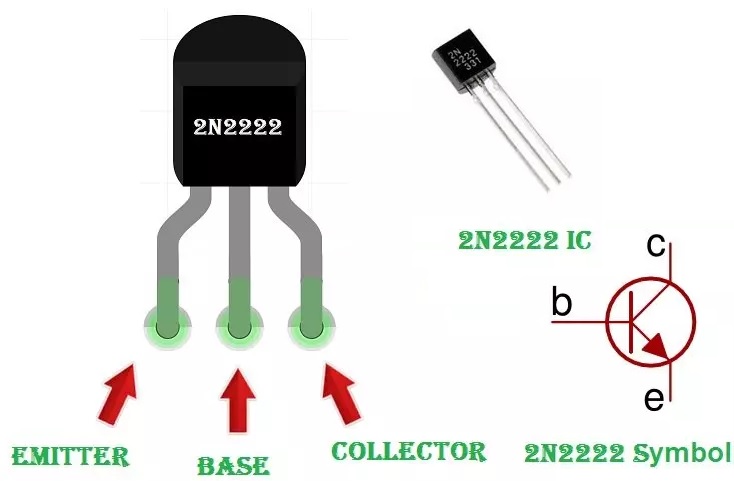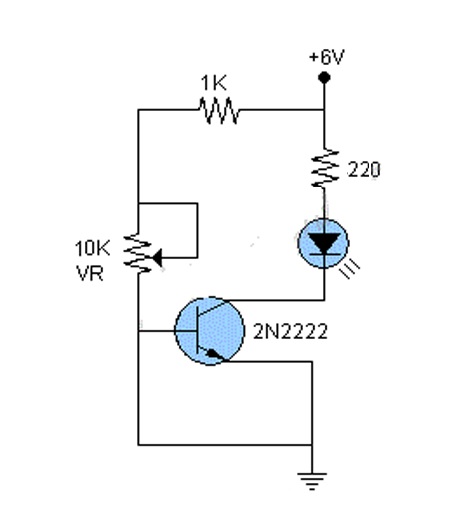AED 1.05
Description
The 2N2222 is a commonly used bipolar junction transistor (BJT) that can be used as a switch or an amplifier. It is an NPN (negative-positive-negative) type of transistor, The 2N2222 can be used as an amplifier and a switch. The 2N2222 is a versatile and low-cost transistor that is widely used in a variety of applications, including digital circuits, power control circuits, and analog circuits.
Package Includes:
- 1 x Transistor NPN 2N2222
Features:
- Type: The 2N2222 is an NPN (negative-positive-negative) type of transistor, meaning it has a layer of p-type semiconductor material sandwiched between two layers of n-type semiconductor material.
- Voltage and Current Ratings: The 2N2222 has a maximum collector-emitter voltage rating of 40V and a maximum collector current rating of 800mA. These ratings determine the maximum safe operating conditions for the transistor.
- Gain: The gain of a transistor, also known as the hFE, is a measure of the transistor's ability to amplify a signal. The gain of the 2N2222 is typically in the range of 100 to 300, which makes it a good choice for a wide range of amplification applications.
- Frequency Response: The 2N2222 has a relatively low maximum frequency of operation, typically in the range of 100 MHz to 300 MHz, making it suitable for low-frequency amplification and switching applications.
- Switching Speed: The 2N2222 has a relatively fast switching speed, which makes it suitable for high-frequency switching applications.
Description:
The 2N2222 is a commonly used bipolar junction transistor (BJT) that can be used as a switch or an amplifier. It is an NPN (negative-positive-negative) type of transistor, which means that it consists of three layers of semiconductor material with different doping types. The 2N2222 is used to control the flow of current in a circuit by acting as a switch. When a small current is applied to the base of the transistor, it controls the flow of a larger current between the collector and emitter, allowing the transistor to act as a switch. The 2N2222 can also be used as an amplifier by applying a small input signal to the base of the transistor and amplifying it to produce a larger output signal at the collector. The 2N2222 is a versatile and low-cost transistor that is widely used in a variety of applications, including digital circuits, power control circuits, and analog circuits.
Principle of Work:
The Bluetooth HC-06 Wireless Transceiver Serial Module is based on Bluetooth technology, which is a wireless communication standard that allows devices to communicate with each other over short distances. The module contains a Bluetooth radio transceiver and a microcontroller that implements the Bluetooth protocol stack. The microcontroller handles the communication between the module and the host device (such as an Arduino) using a simple serial interface. The host device sends AT commands to the module to configure and control its operation, and the module sends and receives data over the Bluetooth connection. When the module is powered on, it goes into discovery mode and waits for a Bluetooth connection from a host device. Once a connection is established, the module operates as a slave device and communicates with the host device over the Bluetooth link. The Bluetooth HC-06 module only supports slave mode and implements the classic Bluetooth SPP (Serial Port Profile), which provides a simple serial communication channel between two devices. The module can be easily configured and controlled with AT commands and supports baud rate adjustment from 9600 to 115200 bps.
Pinout of the Module:

- Collector (C): This pin is used to collect the flow of current. It is typically the largest or middle pin of the transistor and is connected to the load in the circuit.
- Base (B): This pin is used to control the flow of current between the collector and emitter. It is typically the smallest or closest to the collector pin of the transistor and is connected to a current-limiting resistor in the circuit.
- Emitter (E): This pin is used to emit the flow of current. It is typically the farthest from the collector pin of the transistor and is connected to the ground in the circuit.
Applications:
- Amplification: The 2N2222 can be used as a common-emitter amplifier to amplify small signals and produce a larger output signal.
- Switching: The 2N2222 can be used as a switch to control the flow of current in a circuit by turning the device on or off.
- Digital Circuits: The 2N2222 can be used as a digital switch in digital circuits to control the flow of current.
Circuit:
In this circuit, the potentiometer with a resistance of 10 kΩ is used to adjust the brightness of the LED by changing the voltage applied to the base of the 2N2222 transistor. The current-limiting resistor R1 with a value of 1 kΩ is used to protect the base of the transistor, and the resistor R2 with a value of 220 Ω is used to limit the current flowing through the LED. The LED is connected between the collector and emitter of the 2N2222 transistor, and the transistor acts as a switch to control the flow of current to the LED. The 6v power supply is used to provide power to the circuit, and the ground is used to complete the circuit.

Library:
No need to use a library to work with this Transistor.
Code:
no code needed
Technical Details:
- Type: The 2N2222 is a NPN bipolar junction transistor (BJT).
- Collector-Emitter Voltage (VCE): The maximum collector-emitter voltage rating is 40 V.
- Collector Current (IC): The maximum collector current is 800 mA.
- Gain (hFE): The minimum gain of the 2N2222 is 30, and the typical gain is around 100.
- Switching Speed: The 2N2222 has a fast switching speed, with a typical transition time of 30 ns.
- Package: The 2N2222 is available in a TO-92 plastic package.
- Applications: The 2N2222 is commonly used for amplification, switching, and digital circuits.
Resources:
Comparisons:
The 2N2222 and 2N3905 are both NPN bipolar junction transistors (BJTs) commonly used as general-purpose amplifiers or switching devices. However, there are some differences between the two:
-
Voltage rating: The 2N2222 has a higher maximum collector-emitter voltage (VCEO) rating of 60V compared to the 2N3905's VCEO rating of 40V.
-
Current rating: The 2N2222 can handle a higher collector current (IC) of 800mA compared to the 2N3905's maximum IC of 200mA.
-
Gain: The 2N2222 has a higher current gain (hFE) range of 40-300 compared to the 2N3905's gain range of 30-100.
-
Power dissipation: The 2N2222 has a higher maximum power dissipation (PD) rating of 625mW compared to the 2N3905's maximum PD rating of 625mW.
-
Package: The 2N2222 is available in a variety of packages, including the TO-92, while the 2N3905 is typically only available in the TO-92 package.
In general, the 2N2222 is a better choice for applications requiring higher voltage and current handling capabilities, while the 2N3905 is a good choice for low-power applications or when a lower gain transistor is required.